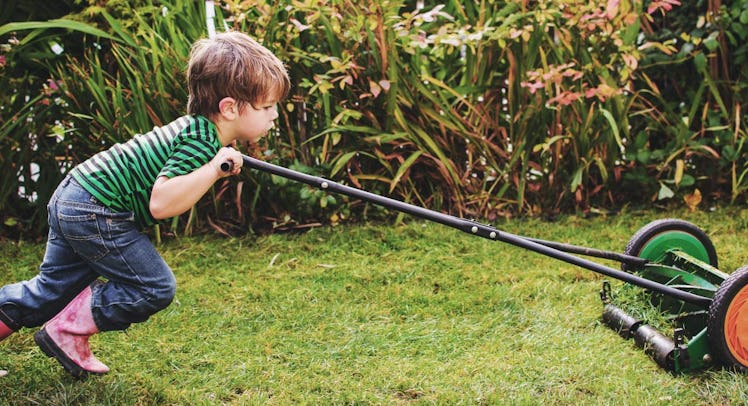How to Give Young Children Rewards for Outdoor Chores and Fun Yardwork
Want a kid to do outdoor chores? Get them a bucket and a trowel.

Chores are good for kids. Experts say so. Research says so. Hell, even articulate kids sometimes say so. There’s a strong correlation between childhood broomwork, educational attainment, and career success. But chores don’t just help because they help. Chores help when parents take a proactive approach early and break a sweat (also, when parents don’t expect measurable success). Because it is relatively high energy and relatively low stakes, yard work is a great way to get little kids working.
READ MORE: The Fatherly Guide to Chores
“I had my kids out working in the yard at six months,” laughs Sarah Pounders, education specialist for the nonprofit KidsGardening.org. “When they’re really young they’re really just out exploring and not participating in getting anything done. My son’s first garden was pot with some soil in it.”
For Pounders, the key to fostering success is meeting the kids where they are. Generally, that’s right behind their parents. And if that leads to shenanigans—yeah, that leaf pile is a target—so be it. Play isn’t the opposite of work. The two are, as anyone who has ever hung out near a water cooler or startup ping-pong table can tell you, entwined.
In fact, play and work are hard to separate for kids when it comes to outdoor chores. For the youngest yard workers, Pounders recommends watering. Kid-sized watering cans with small holes allow kids to give a drink to outdoor plants, flowers and vegetables, though parents should expect their kid to get wet, so appropriate yard-work attire is recommended. By 5 or 6 years old they can start using the hose.
As a child’s strength and dexterity grows through the toddler and preschool years, Pounders says that parents should provide their kid with two essential yard work tools: a spade and a bucket. These tools can be applied to any number of activities. Kids will enjoy collecting yard debris that could affect lawn mowing by putting seed pods, sticks or rocks in a bucket and moving them to a dump pile. They can use the spade and bucket to help move mulch. They can move dirt to flower and garden beds and help plant by using the trowel.
It’s important to note that, with the exception of smaller, lighter-weight rakes and good kid-sized yard work gloves, parents don’t need to buy kid-specific tools. They are often flimsy and overpriced. “You want to go with high-quality tools,” Pounders says. “You want to make sure they’re not getting broken down or giving your kid old tools that are rusted.”
When kids get into elementary school, they will be able start using bladed tools with adult supervision. It’s important to start by modeling proper safety with the tools before handing them off, but many kids will love sawing off small branches with a branch say or trimming long grass edges with sheers. Still, parents need to stay close and alert.
Adding power tools into the mix actually depends less on age than it does height. While a middle school kid might be capable of mowing or weed-whacking, they may not actually be tall enough to use the tools properly, which can create a real hazard.
The important part is that parents want to foster a love of being outdoors and managing the cultivated ecosystem of the yard. In many respects, that requires following their lead rather than forcing them into something they’ll hate, like weeding, according to Pounders. “It’s something you want to do in moderation and not spend too much time on. Do a little bit and be done with it.”
This article was originally published on